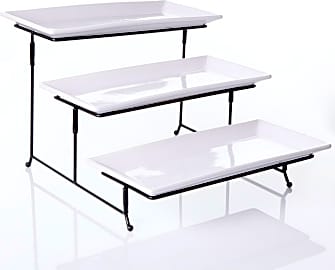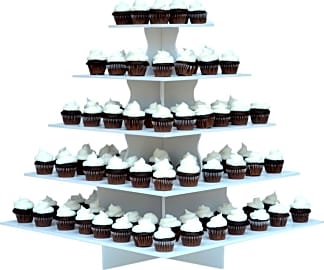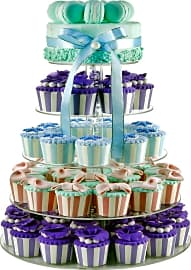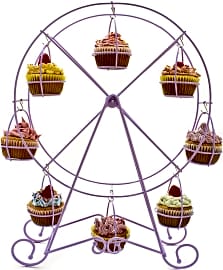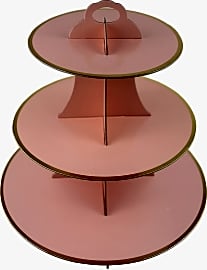The 10 Best Cupcake Stands

This wiki has been updated 37 times since it was first published in September of 2015. If you dream of towers of cupcakes and have the talents in the kitchen to make them, then one of these stands will be excellent for shining a spotlight on your baking skills. Coming in a range of styles and capacities, from a small handful to dozens of desserts, one of these models will work for home and pastry shop use, as well as for parties, weddings, and other events. When users buy our independently chosen editorial picks, we may earn commissions to help fund the Wiki.
Editor's Notes
April 08, 2020:
Ample time had passed between our last update and today, so we made a handful of changes to ensure our selections are up to snuff. We removed the Adorox Treat Stacker and replaced it with the sturdier My Party Time Tower, which comes in at the same low price and is available in a variety of charming colors, metallics, and patterns. When the Juvale Colorful became unavailable, we filled the void with the Weepa Rainbow, a similar option of relatively durable quality that has a lovely iridescent sheen that is aesthetically pleasing. It's also offered in Halloween and unicorn themes and in sheeny rose gold as well.
Due to numerous complaints regarding the HBAshoppe Stacked's stability and durability, and its high price tag, we decided to scrap it in favor of the Kwirkworks Twisted. This statement piece is perfect for those who need something hard-wearing for multiple events, and its steel construction makes it appropriate for black tie fetes and weddings. It can be accessed from any angle and easily restocked, which makes it user friendly for guests.
We curated our selections based on aesthetic appeal, quality construction, durability, value for money, easy assembly, and capacity. Many of the items on this list are transparent, white, or a subtle color, making them complementary to a host of decors, other table settings, and cake stands.
Special Honors
August Grove Odaniel An heirloom-quality piece that's hand-wrought in an artistic tree of life design, the Odaniel is solid, sturdy, and attractive. Each of its three tiers holds a heavy gauge steel disk with ample room to support a large cake, pie, or multitude of cupcakes. This whimsical stand is adorned with a small metal bird and is durable enough to function for years. wayfair.com
Christofle Jardin d'Eden Made in France by the renowned silversmiths at Christofle, the Jardin d'Eden is named after the most famous garden in history. Ideal as a wedding gift or for use during upscale events, this silver-plated baroque two-tier dessert stand is topped with a charming apple instead of a finial knob. Each plate sports an intricate verdant pattern by designer Marcel Wanders that's characterized by interlacing vines, plants, and flowers. christofle.com
Crate & Barrel Wood Marble This stately two-tiered stand is comprised of warm wood and cool marble and perfectly complements rustic, farmhouse, and minimalist themes. A tapered mango wood dowel provides sturdy support and sports a charming knob handle. Two white marble platters are generously sized for tea sandwiches, cupcakes and more, but be aware that some foods, such as beets, can stain their surfaces. crateandbarrel.com
A Brief History Of The Cupcake
To start, there are two histories that may mark the beginning of cupcakes as we know them.
The humble cupcake is a near-perfect creation. It’s the same as a standard-sized cake, except that it’s yours alone to enjoy — no sharing necessary. These personal treats have become a baking mainstay everyone is familiar with, and are a must-have addition to events and parties. While cakes have been around for thousands of years, the cupcake is a relative newcomer to the dessert scene. So, how did a communal confection turn into an intimate indulgence?
To start, there are two histories that may mark the beginning of cupcakes as we know them. First, there was the cup cake, a plain-tasting yellow treat that consisted of one cup of butter, two cups sugar, three cups flour, and four eggs — an easy enough recipe to recall without having to write it down. Because of this, they were also known as 1-2-3-4 cakes. When a baker saw a recipe for a cup cake, she knew she would use volume measurements rather than weight (like with a pound cake). While compact cups were occasionally used for baking, the batter was more commonly layered in tins and cooked as loaves.
The second account has to do with the size of the comestible instead of how one measured it. In the late 18th century, things like muffin tins weren’t widely available, so when you wanted a batch of small cakes, you used individual ramekins or molds. The first known written record of a cupcake comes from author Amelia Simmons’ 1796 cookbook American Cookery. In it, she describes a recipe for a “light cake to be baked in small cups”, which included ingredients like wine and rosewater. A couple decades later, in 1828, renowned writer and domestic expert Eliza Leslie distinctly referenced cupcakes in her successful book Seventy-Five Receipts for Pastry, Cakes, and Sweetmeats.
At the turn of the 20th century, muffin tins grew in popularity and were more widely distributed, making it simpler than ever to bake at home. Many preferred the efficiency of making a handful of individual cakes to the traditional larger cake, which took longer and was easier to burn. In 1919, Hostess unveiled their delectable chocolate snack cake, the mark of the beginning of the commercialization of cupcakes. When Hostess employee D.R. "Doc" Rice helped rework the design in the 1950s, it took on the appearance we're familiar with today. The updated product featured a looped white line of icing over the top and vanilla creme filling.
Putting Your Best Bake Forward
There is no shortage of events where cupcakes would be a welcome treat. Whether it’s a birthday party, bridal shower, or housewarming, a batch of sumptuous cupcakes will rule supreme on the dessert table. While there’s nothing inherently wrong with simply laying them out on a platter, using a tiered stand is an instant way to present your show-stopping sweets in an elegant arrangement that commands attention.
They're also limited in what type of confection they can hold.
Cupcake stands are made from a handful of materials, each of which has its benefits and drawbacks. If you’re constantly hauling your coveted confections to office parties, PTA meetings, and brunches, a plastic collapsible option might do well for you. Plastic, while not the most attractive material, is light and effortless to carry, not to mention it's easy to decorate to match a theme. A collapsible option means you can choose how many tiers you’d like to use, and you’ll appreciate the ease with which you can break it down once the party is over.
If you don’t want to sacrifice style, yet still need something sturdy and lightweight, consider transparent acrylic. Many acrylic designs have tiers that screw securely into place, so they’re stable enough to handle the weight of whatever snack you set on them. Because they resemble glass, they add a sophisticated look and can complement any motif.
For upscale fetes or to simply add an extra dose of panache, there are rust-proof metal styles that use pliable holders instead of tiered plates. These are usually straightforward to wash and disassemble, and they offer convenient handles that enable you to move them around without risking disaster. Arranging your cupcakes in these takes a bit of time and a steady hand — you'll want to keep a napkin handy for icing mishaps. They're also limited in what type of confection they can hold.
Cardboard is exceptional for one-time events or seasonal use, and you can usually recycle it when all is said and done. Like plastic, it's easy to decorate if needed, and selections are available in everything from gold and silver to iridescent. They're great for children's birthday parties or holiday get-togethers, but don't expect to get more than a few uses out of them.
A Few Helpful Hacks
Everyone has their own way of doing things in the kitchen, but that doesn’t mean we can’t all learn a few new tricks every now and again. Below are a couple of ideas to try when you’re whipping up your next batch of red velvet delectables.
To give your batter a little something extra, try swapping out a small portion of the milk for plain or vanilla flavored yogurt.
If you’ve run out of frosting or don’t have the time to make any, consider using large marshmallows instead. Simply place one on every cupcake about five minutes before they’ve finished baking. They’ll melt evenly and give each cake a generous coating with a lovely toasted appearance and taste. If you only have powdered sugar on hand, sift some through a piece of lace for an elegant-looking dessert without all the extra calories.
To give your batter a little something extra, try swapping out a small portion of the milk for plain or vanilla flavored yogurt. It will create an exceptionally light and airy texture, plus it adds a subtle tang.
As a general rule, let your eggs, milk, and butter come to room temperature prior to blending them. You can leave them out for a couple of hours before you begin baking if you’ve got the foresight. If you’re pressed for time and need to heat your eggs up quickly, place them in a bowl of lukewarm water for five minutes. Your ingredients will bond together better on a chemical level, making a smooth batter that will result in a much fluffier cupcake.




